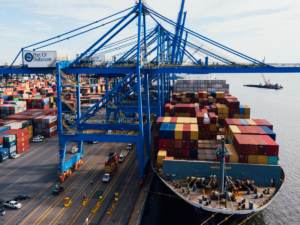4 Things to Know About Modern Slavery Risks in Shipping to Carry Out the 3 Steps Toward Supply Chain Sustainability
When detecting modern slavery risks, one that often goes unnoticed is the risk in the maritime supply chains. Many businesses outsource this function and, thus, may need to learn the employment situation within their supply chain.
Given the high volume of workers required for loading, unloading, repairing, and other daily tasks in shipping, the vast and complex supply chain is vulnerable to modern slavery risk. Suppliers may overlook workers’ human rights when trying to cut costs to deal with the recession on a tight budget.
Yet, shipping is an essential component of the supply chain for transporting freight, accounting for 90% of global trade. Despite its importance, supply chain workers face severe exploitation, jeopardising a company’s supply chain sustainability.
The Mekong Club has spent a decade developing solutions and tools to end modern slavery in supply chains. And here are four things you should know about modern slavery risk in shipping before taking the following three steps to ensure supply chain sustainability.
Let’s dive right in.
OVERVIEW OF MODERN SLAVERY RISK IN SHIPPING
- What is modern slavery risk in shipping?
Shipping modern slavery risks occur when many seafarers are exploited and abused—for example, extended working hours, fraudulent employment contracts, low pay, and a lack of food and drinking water.
The worst-case scenario is abandonment. It involves the shipowner leaving the seafarers without contact, money, food, or transportation to home.
- Why is the prevalence of modern slavery risk in shipping?
The shipping industry can enjoy less stringent regulations using flags of convenience (FOC), which enhances the modern slavery risk. FOC-registered vessels sail under a foreign flag.
For example, a ship can be registered in Liberia, owned by a Greek company, chartered by a Chinese company, and crewed by Filipinos. It’s challenging to track down each of these parties and determine who is to blame for any transgressions.
Most ship owners register their vessels under a FOC. FOC provides minimal regulation, preferential registration fees or tax benefits, and the ability to hire labour anywhere in the world. As such, ship owners may leverage FOC to use migrant workers and exploit them.
These migrant seafarers lack access to information about their rights and may not speak the local language. They face significant challenges in determining what slavery is and how to report it. They also work in isolated conditions, away from friends and family, making it difficult to receive support and escape.
- Where are modern slavery risks in shipping?
The modern slavery risk in shipping exists all over the world. The Australian Maritime Safety Authority (AMSA) has recently prohibited bulk carriers flagged in Panama, Liberia, Hong Kong, and Singapore, though many cases remain unidentified.
AMSA banned these ships for underpaying or failing to pay their seafarers. These ships also violated other Maritime Labour Convention (MLC) involving working conditions, accommodation, food and medical care and other rights.
- Why care about modern slavery risk in shipping? Simple. Supply chain sustainability.
Supply chain sustainability is essential to help your business thrive in terms of productivity, sales, and market value.
When a company addresses modern slavery risks in shipping, such as long working hours and a lack of food, worker satisfaction, retention, loyalty, and productivity would increase throughout the supply chain.
Consumers will see the company assuming corporate social responsibility when businesses report efforts to end shipping modern slavery risks. As a result, customer loyalty and sales may improve.
Following the “S” indicators and addressing modern slavery risks in shipping supply chains can reassure investors that shipping modern slavery will not jeopardise a company’s reputation. This avoids lowering its market value.
With increasing expectations from stakeholders on supply chain sustainability, addressing modern slavery risk in the shipping supply chains would be a significant first step.

STEP-BY-STEP GUIDE TOWARD SUPPLY CHAIN SUSTAINABILITY
- Identify modern slavery risks in shipping
The first step toward supply chain sustainability is to map your organisation’s structure and conduct a risk assessment to determine how much work needs to be done. There are four significant issues to consider when evaluating:
- Are your suppliers and vendors upholding their Supplier Code of Conduct or modern slavery-related commitments?
- Do effective grievance and whistleblowing mechanisms exist?
- Is your organisation supplementing information provided by suppliers with on-site audits and meetings with their workforce
- Is your workforce aware of and trained to recognize the signs of modern slavery risk?
To comprehend these four issues, it is necessary to understand who and what managerial positions within an organisation can play an essential role in reducing modern slavery risks within supply chains.
You can conduct due diligence on managers, agents, officers, and, in the case of time or voyage charterers, the counterparty ship owners. You can also pose the following questions to them:
- Could you please explain your supply chain sustainability policy to me?
- Do you know any known modern slavery risks in the shipping supply chain?
A solid understanding of the above four areas will assist you in determining how vulnerable your company is to the modern slavery risks in shipping.
- Manage identified modern slavery risks in shipping
After identifying and assessing modern slavery risks in maritime supply chains, you may wonder how to address the identified risks. You may conduct additional due diligence on the entity’s operations and supply chains to review and adapt contract terms and supplier codes of conduct. Then, carrying out remedial steps where modern slavery is identified.
- Prevent modern slavery risk in shipping
Now that you know how decision-makers and employees in your company contribute to modern slavery risks prevention. You also have tackled the identified risks. To ensure supply chain sustainability, you can move on to prevent future modern slavery risks in shipping.
- Track suppliers to identify potential modern slavery risks in shipping.You can conduct self-assessments and site visits regularly for higher-risk third-party shipping suppliers and contractors to detect modern slavery risk and propose improvements to strengthen their governance systems. You can also see if the vessel has been barred from entering ports due to MLC violations.
- Through risk assessments and internal audits, implement processes and KPIs to track the effectiveness of steps to eliminate modern slavery risk in shipping to ensure supply chain sustainability.
- Educate employees about shipping modern slavery risks and their ramifications. As part of their induction training, you can provide modern slavery awareness training to all your employees and new hires. This can let them know and avoid modern slavery risks in the maritime supply chain.
- Stay current on the shipping industry trends. Our online search tools assist businesses in delving deeper into industry-specific topics by searching archived news articles, blogs, and websites from credible sources. This can let you comprehend the complexities of managing modern slavery risk in shipping.
- Hire a compliance officer responsible for the above steps if needed.
- Formulating modern slavery policies will entail gathering current policies, identifying gaps, adapting existing policies, and developing new procedures. You can conduct internal audits in compliance with the Modern Slavery Act. You can also ensure that all new supplier agreements include contractual clauses prohibiting slavery. We also recommend that you keep a channel open for reporting potential noncompliance. With Diginex, we created an innovative tool for workers’ voices called Apprise Audit. The Apprise Audit system will allow companies and front-line responders to interview workers anonymously and remotely in their native language to ensure your supply chain is slave-free.
CONCLUSION
Identifying and addressing modern slavery risks is a significant barrier to sustainable supply chains. However, with the above three steps of proper inspection, training, tools and policy, you can protect people suffering from slavery in the shipping supply chain.
To learn more, join us for our upcoming webinar on November 24th at 16:00 GMT+8. To register follow the link by clicking here.
___
For more information on Apprise Audit, get in touch to learn how we can help you to collect essential information on working conditions in your shipping supply chain at [email protected].
Author: Tsz Yin Wong
__
Reference:
https://www.tlblaw.com.au/modern-slavery-in-supply-chain/
https://www.nortonrosefulbright.com/en/knowledge/publications/b87356e9/modern-slavery-and-human-trafficking-reporting-the-risks-of-modern-slavery-in-maritime-supply-chains
https://www.swireshipping.com/information/info-pages/sustainability/modern-slavery/

